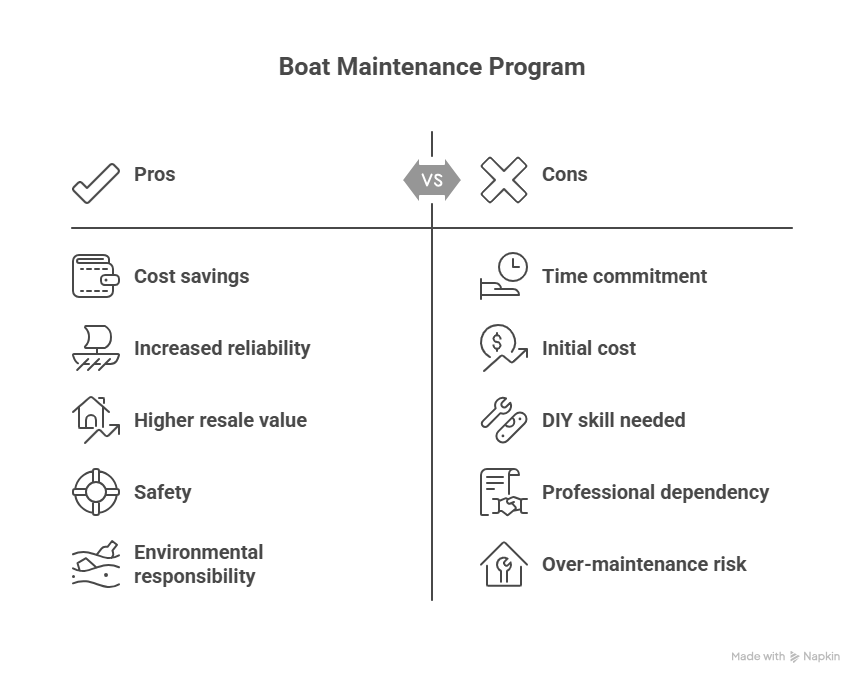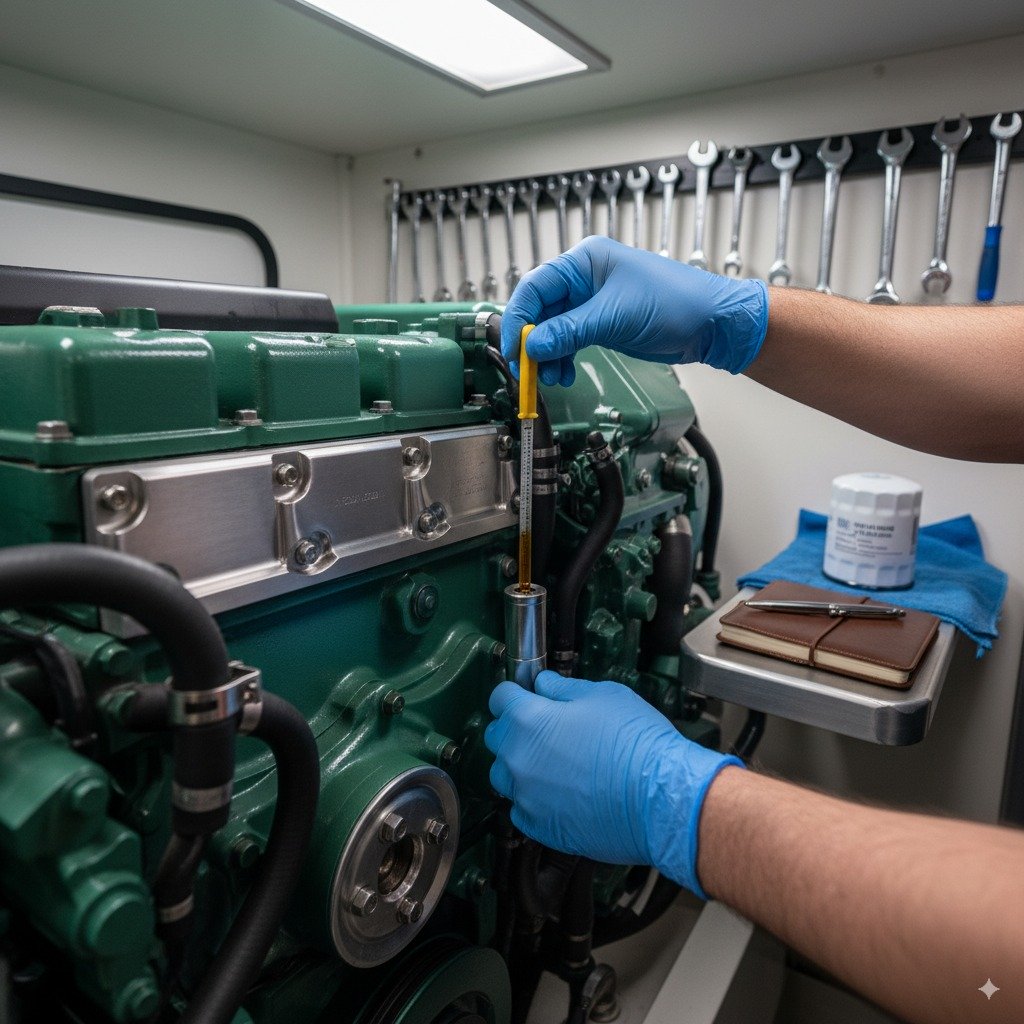That Gut-Punch Feeling Off Stiltsville
I’ll never forget the call I got last summer. A guy named Frank, new owner of a beautiful Sea Ray, stranded halfway to Bimini with his family. Engine just died. No warning, just silence. By the time the tow boat got him back to Miami, the bill was a gut-punch, and the repair for his seized engine was even worse. The cause? A simple, clogged oil filter he’d ignored for two seasons.
As a marine mechanic in South Florida for 20 years, I’ve seen this story play out a hundred times. A beautiful day on the water ruined by a problem that was 100% preventable. People think boats just break, but most of the time, they’re broken by neglect. That’s why I’m a fanatic about a regular vessel and engine maintenance program. It sounds formal and boring, I know, but trust me—it’s the only thing standing between you and a guy like Frank’s very bad day.
This guide isn’t a textbook. It’s my real-world advice, the stuff I tell my clients at Dinner Key Marina. We’re going to build a simple, effective maintenance plan that keeps you on the water and out of my repair shop.
Table of Contents
Why a Maintenance Program Saves Your Bacon (and Wallet)
Let’s get one thing straight: a regular vessel and engine maintenance program isn’t about spending money, it’s about saving it. That emergency tow and repair for Frank? It cost him nearly three times what a few years of scheduled service would have.
Think of it this way: you can either pay for maintenance on your schedule, at the dock, with a coffee in hand. Or you can pay for it on the ocean’s schedule, with a storm brewing and a tow boat captain who knows you’re desperate.
I break down my approach into two parts:
- The Scheduled Stuff (Preventative): This is the boring but critical work. Changing oil every 100 hours, swapping impellers every spring, checking zincs. It’s the stuff you do before it breaks.
- The Smart Stuff (Predictive): This is where you listen to your boat. I tell my clients to send oil samples to labs like Blackstone. For a few bucks, they can tell you if there are metal shavings in the oil, signaling a bearing is about to fail. That’s the kind of intel that lets you fix a $500 problem before it becomes a $15,000 one. A smart regular vessel and engine maintenance program uses both.
The Nuts and Bolts: What My Program Actually Looks Like
Forget complicated charts. Your engine needs a few key things to stay happy. Here’s a simple checklist I give my clients. It’s the core of any good regular vessel and engine maintenance program.
| Task | My Recommended Interval | Why It Matters (The Short Version) |
|---|---|---|
| Engine Oil & Filter | Every 100 hours or annually, period. | Clean oil is cheap. A new engine isn’t. |
| Fuel Filters | Annually, or more in dirty tanks. | Keeps gunk out of your injectors. Ethanol fuel is a nightmare. |
| Cooling System/Impeller | Inspect every 100 hours, replace annually. | An impeller is a $50 part. An overheat will cost you thousands. |
| Zincs/Anodes | Check every month, replace at 50% gone. | They die so your expensive metal parts don’t. |
| Belts & Hoses | Visually inspect before every trip. | A cracked hose or slipping belt can shut you down in minutes. |
The Lifeblood: Oil and Fuel
Your engine’s oil is everything. I don’t care if you only used the boat for 20 hours last year—moisture and contaminants build up over time. Change it annually, no excuses. And use good marine-grade oil.
Fuel is the other big one, especially here in Florida with ethanol-blended gas. Water in the fuel is a constant battle. Check your fuel-water separator before every trip and have extra filters on board. A solid regular vessel and engine maintenance program is built on clean fluids.
Keeping it Cool and Charged
I saw a cooling hose let go on a client’s boat once. He caught it in seconds because he was paying attention. A few gallons of water in the bilge was a nuisance. If he hadn’t, it would have been a cooked engine. Check your hoses, clamps, and especially that little rubber impeller.
And your electrical system? Keep those battery terminals clean and tight. Corrosion is the enemy. I’ve fixed more “dead” engines by cleaning a battery terminal than I can count.

The Logbook: Your Engine’s Best Friend
If you take one piece of advice from this article, let it be this: keep a detailed logbook. Every oil change, every filter swap, every weird noise you heard—write it down with the date and engine hours.
Why? Two reasons.
- Troubleshooting: When you call me and say, “It’s making a weird noise,” my first question is, “When was the last time you changed the impeller?” Your logbook has the answer.
- Resale Value: I had a client sell his 10-year-old Tiara for top dollar last year, and the buyer said the meticulous logbook was the deciding factor. It proves the boat was cared for. A detailed log is a critical part of a complete regular vessel and engine maintenance program. It’s your boat’s resume.
DIY vs. Calling a Pro (Like Me)
You can absolutely do some of this yourself. Checking fluids, visual inspections, cleaning strainers—these are great ways to get to know your boat and save a few bucks. Your owner’s manual is your best friend here.
But know your limits. When it comes to engine timing, complex electrical diagnostics, or anything that could sink the boat if you get it wrong, call a professional. A good regular vessel and engine maintenance program is a partnership between you and your mechanic. We have the specialized tools and experience to spot things you might miss.
A Quick Word on Not Hurting Yourself (or the Manatees)
Safety first, always. Engines are hot, heavy, and full of flammable fluids. Disconnect the battery before working on electrical systems. Wear gloves and eye protection.
And be kind to the environment. That used oil, coolant, and old batteries? They are toxic. Dispose of them properly at a marina or auto parts store that accepts them. A responsible regular vessel and engine maintenance program includes protecting the water we all love.
FAQ: Questions I Get at the Dock
How often should I really check my oil?
Before every single trip. It takes 30 seconds. Look at the level and the color. It’s the easiest way to catch a problem early.
What’s the one thing people always forget?
The sacrificial anodes (zincs). People see them on the outside, but they forget the ones inside the engine. They’re silently protecting your engine from corrosion. A well-planned regular vessel and engine maintenance program never overlooks them.
Is a logbook really that important?
Yes. It’s the single best tool for increasing your boat’s value and making my life easier when something goes wrong.
Can I just use car oil in my boat engine?
Don’t do it. Marine engines run under different loads and in a corrosive environment. Marine oil has additives to protect against rust and moisture that car oil just doesn’t have.
My engine is running fine. Why do I need a maintenance program?
Because it’s running fine now. The whole point of a regular vessel and engine maintenance program is to keep it that way and prevent the “sudden” failure that leaves you stranded.
The Bottom Line: Be Proactive, Not Reactive
At the end of the day, a boat is a machine. And like any machine, it needs care. You can either be proactive and give it that care on your own terms, or you can be reactive and deal with problems when they pop up at the worst possible moment.
Frank, the guy with the seized Sea Ray? He’s now one of my most diligent clients. He learned the hard way that a good regular vessel and engine maintenance program isn’t a chore—it’s freedom. It’s the confidence to point your bow toward the horizon and know you’re going to get there and back, no drama.
Start small. Get a notebook and start your log. Check your oil and your fuel filter. Build your habits. Your boat—and your wallet—will thank you for it.
Author Bio
I’m Alex, a 15-year marine technician in South Florida, ABYC-certified. My specialty is creating and managing a regular vessel and engine maintenance program for my clients, from weekend fishermen to long-range cruisers. I’ve seen firsthand how proactive care prevents costly disasters at marinas like Coconut Grove and Bahia Mar.


Leave a Reply